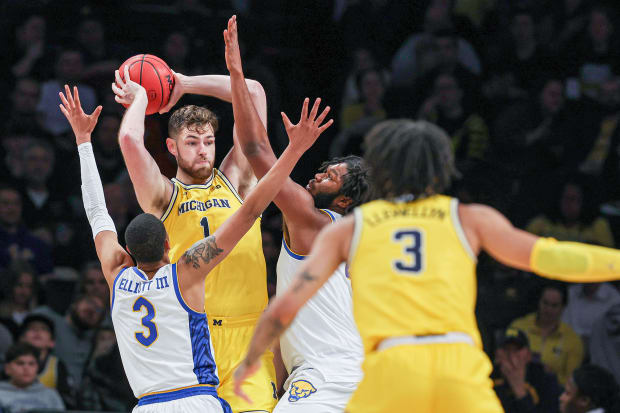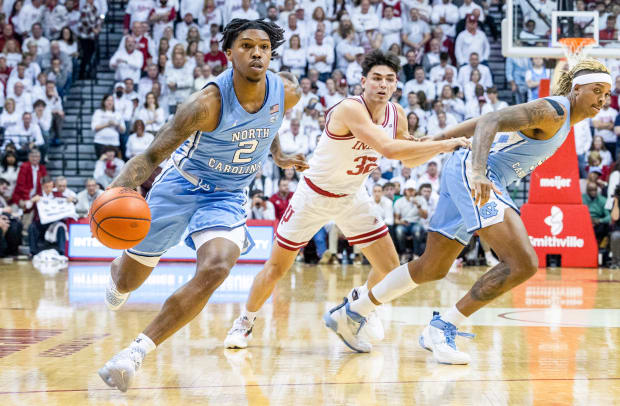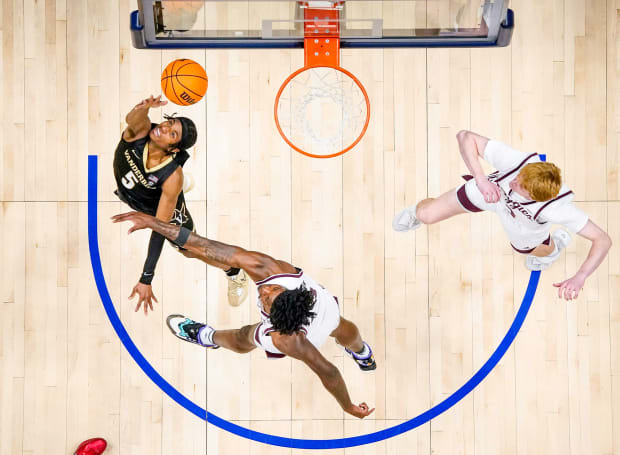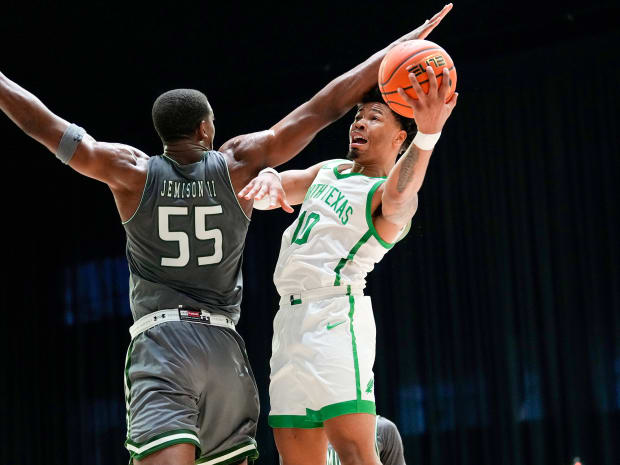If your program didn’t make this year’s NCAA tournament, it likely would in one of these debated 80-team or 96-team formats.
The men’s NCAA tournament field of 68 is out, and the march to Houston for the Final Four begins Tuesday with the First Four in Dayton. But in what is a transformational time in college athletics, conference commissioners, athletic directors and coaches have ignited dialogue in recent months about significant changes to March Madness. The biggest one discussed: expanding the NCAA tournament field.
No change is imminent, but with many of the sport’s most powerful people openly discussing it, it’s worth exploring what an expanded tournament would hypothetically look like with this year’s field.
Why is expansion under consideration?
Perhaps the most vocal proponent of expansion is SEC commissioner Greg Sankey, who began his more outward push for growing the field after SEC member Texas A&M was left out of the Big Dance in 2022 despite a late-season, seven-game winning streak. The Aggies went on to reach the NIT title game.
“I think [Texas] A&M was playing as well as anyone in men’s basketball last March and didn’t have access,” Sankey said in October. “Then you look at baseball, where Ole Miss was recognized as the last team in and … wins the national championship. It opens your mind.”

Illustration by Sinelab
Once again this March, one team left out that believed it had the best chance to make a run based on how it was playing down the stretch comes from the SEC. This time, it’s Vanderbilt, which won 10 of its final 12 games after a 10–12 start to play its way into the NCAA tournament conversation. The Commodores dug themselves into too deep a hole in nonconference play after losses against Southern Miss and Grambling State, and its NET ranking was the worst among bubble teams.
But even modest expansion to 80 teams means inviting plenty of teams that haven’t played well down the stretch. Oklahoma State, losers of six of eight to close the season, would comfortably be in the field. Wisconsin, 6–12 in its final 18 games, also would have got in. North Carolina, which went 1–9 in Quad 1 games, would have made the Dance, as would have Michigan, a ghastly 2–12 in such games.
There would still be drama around the cut line, but conference tournaments would lose a bit of intrigue if most bubble teams were eliminated in the first and second rounds. That hasn’t stopped the push for expansion. Baylor coach Scott Drew, who took the Bears to the national championship in 2021, has proposed a 128-team field, citing parity and the size of the postseason in football. Missouri coach Dennis Gates also endorsed a 128-team model: “There are some great coaches left out of the tournament and some great players we don’t get to see,” he said October.
That level of expansion (approximately 35% of the sport’s 363 teams) is incredibly unlikely at this point. The NCAA Transformation Committee recommended each sport’s governing body consider expanding to 25% of Division I, which in college basketball would come out to around 90 teams. That’s why a popular model is 96 teams, which would be a 50% increase in the number of tournament teams. A 96-team field was discussed more than a decade ago when the tournament was expanded from 65 to 68 and at one point was considered “the best fit logistically and financially.”
The logistics

Vincent Carchietta/USA TODAY Sports
Fitting an expanded tournament into the existing three-week framework feels important, but it is logistically challenging. Getting teams to NCAA tournament sites on short notice has already been an issue in recent years, including a gaffe last year that included Colorado State not getting its final travel plans until after midnight ET on Tuesday morning despite playing the first game of the tournament Thursday morning.
- Printable NCAA brackets: Men’s | Women’s
- Round-by-round bracket predictions: Pat Forde | Kevin Sweeney
- Pat Forde ranks all 68 teams in the men’s tournament
- How to bet on the men’s NCAA tournament
A best-case scenario would be starting play-in games Wednesday and Thursday before round of 64 games on Friday and Saturday and round of 32 games Sunday and Monday. That would require all 32 teams playing Wednesday to travel Monday, potentially less than 24 hours after the Selection Show. If Wednesday is too difficult logistically, a Thursday start would allow the traditional “first weekend” to wrap up by Tuesday and keep Sweet 16 games on their usual schedule.
One problem with this model: Teams likely wouldn’t have enough time to return to campus between the first and second weekends of the tournament, meaning more missed classes for athletes. Another potential concern would be increased overlap with the rapidly growing women’s NCAA tournament, which currently staggers its start by a day compared to the men’s event.
Would this be good for college basketball?
There are compelling cases on both sides. The exclusivity of the NCAA tournament is part of what makes it special. For all teams but a few perennial powers, a successful season is defined by making the Big Dance, and the celebration videos of teams seeing that dream realized prove it. Devaluing that accomplishment, and giving the regular season less meaning in the process, could be a mistake.
On the other hand, as Drew and Gates point out, a lot of special players miss out on the tournament every year. Giving players more chances to fulfill their dreams and giving fans more potential Cinderella stories wouldn’t be a bad thing. What college basketball fan would say no to having more NCAA tournament games to watch? And in a world where media rights deals fund most things in college sports, more inventory means more revenue.
With the number of key stakeholders interested in expansion and fields likely to grow in other sports in the coming years, this debate isn’t going anywhere.
The 80-team model

Trevor Ruszkowski/USA TODAY Sports
This expansion model would essentially put any team that was in the bubble conversation for the final two weeks of the season into the field. The last team in this projected field was Michigan, with New Mexico, North Texas, Cincinnati and Florida as the first four teams out. That’s a strong enough cut line that there would still be some drama coming down the stretch, but it would diminish the importance of regular-season games if teams like 17–16 Colorado made the cut.
The other obvious note when looking at this bracket (which is evident in all three models) is how much more difficult the round of 64 games would be for No. 1 seeds. Top overall seed Alabama’s reward for its remarkable season is a matchup against Wisconsin or Furman (a No. 13 seed in this year’s 68-team tournament) rather than a traditional No. 16 seed. The only way to soften these games for the top seeds is to reseed after the play-in round, but that comes with one major problem: How would fans fill out a bracket?
In the current First Four model, most brackets don’t require you to pick winners until the round of 64. That wouldn’t be a tenable model here. TV ratings for the First Four are dwarfed by Round of 64 games: Indiana’s game against Wyoming, which set First Four records, averaged 2.2 million viewers, numbers often topped by multiple games in the same television window during the first round. Plus, the 64-team main draw wouldn’t be finalized until the night before the next round of games begins, a disaster for getting fans to fill out brackets. That would be a major issue, particularly given the proliferation of legal gambling and daily fantasy games that are popular during March Madness.
South Region
- No. 1 Alabama vs. No. 16 Wisconsin or No. 17 Furman
- No. 8 Iowa vs. No. 9 FAU
- No. 5 SDSU vs. No. 12 Rutgers
- No. 4 Virginia vs. No. 13 North Carolina or No. 20 FDU
- No. 6 TCU vs. No. 11 NC State
- No. 3 Baylor vs. No. 14 VCU or No. 19 Princeton
- No. 7 Texas A&M vs. No. 10 Utah State
- No. 2 Marquette vs. No. 15 Kent State or No. 18 Colgate
Midwest Region
- No. 1 Houston vs. No. 16 Vanderbilt or No. 17 Louisiana
- No. 8 Maryland vs. No. 9 West Virginia
- No. 5 Duke vs. No. 12 Oklahoma State
- No. 4 Indiana vs. No. 13 Charleston or No. 20 SEMO
- No. 6 Kentucky vs. No. 11 Providence
- No. 3 Gonzaga vs. No. 14 Drake or No. 19 UNC Asheville
- No. 7 Michigan State vs. No. 10 USC
- No. 2 Arizona vs. No. 15 Sam Houston or No. 18 Vermont
West Region
- No. 1 Kansas vs. No. 16 Colorado or No. 17 Kennesaw State
- No. 8 Arkansas vs. No. 9 Illinois
- No. 5 Saint Mary’s vs. No. 12 Nevada
- No. 4 Tennessee vs. No. 13 Oral Roberts or No. 20 Texas Southern
- No. 6 Iowa State vs. No. 11 Mississippi State
- No. No. 3 Xavier vs. No. 14 Michigan or No. 19 Northern Kentucky
- No. 7 Missouri vs. No. 10 Penn State
- No. 2 UCLA vs. No. 15 Liberty or No. 18 Montana State
East Region
- No. 1 Purdue vs. No. 16 Texas Tech or No. 17 UCSB
- No. 8 Memphis vs. No. 9 Auburn
- No. 5 Miami vs. No. 12 Arizona State
- No. 4 UConn vs. No. 13 Clemson or No. 20 Texas A&M-CC
- No. 6 Creighton vs. No. 11 Pittsburgh
- No. 3 Kansas State vs. No. 14 Oregon or No. 19 Howard
- No. 7 Northwestern vs. No. 10 Boise State
- No. 2 Texas vs. No. 15 Iona or No. 18 Grand Canyon
Teams from 2023 that get in: Oklahoma State, Rutgers, North Carolina, Clemson, Oregon, Vanderbilt, Sam Houston State, Liberty, Colorado, Texas Tech, Wisconsin, Michigan.
Teams that are still out: New Mexico, North Texas, Cincinnati, Florida, Washington State
The 96-team model including regular-season autobids

Andrew Nelles/The Tennessean/USA TODAY Network
In this model, every conference now receives the potential for two automatic bids: one for winning the league’s regular-season title and another for winning the conference tournament. This year, it would mean the 11 teams that were No. 1 seeds in their conference tournaments but lost get in, from low-majors like Alcorn State to dangerous mid-majors like Bradley and Yale.
This model was favored by Mike Krzyzewski, among others, when a 96-team field was proposed in 2010. It would also add some significant drama for fans of bubble teams during conference tournament week, as every No. 1 seed that loses results in one fewer at-large spot in the Big Dance.
Assuming the rule that a team must be .500 or better for at-large consideration remained in place, this style of expansion would essentially take the vast majority of this year’s NIT field and put them in the NCAA tournament. We added five more at-large bids from the 80-team model, with those teams being New Mexico, North Texas, Cincinnati, Florida and Washington State.
South Region
- No. 1 Alabama vs. No. 16 Wisconsin or No. 17 New Mexico
- No. 8 Iowa vs. No. 9 Florida Atlantic or No. 24 Fairleigh Dickinson
- No. 5 San Diego State vs. No. 12 Rutgers or No. 21 Grand Canyon
- No. 4 Virginia vs. No. 13 Charleston or No. 20 UC Irvine
- No. 6 TCU vs. No. 11 NC State or No. 22 UNC Asheville
- No. 3 Baylor vs. No. 14 VCU or No. 19 Toledo
- No. 7 Texas A&M vs. No. 10 Utah State or No. 23 Northern Kentucky
- No. 2 Marquette vs. No. 15 Kent State or No. 18 Yale
Midwest Region
- No. 1 Houston vs. No. 16 Michigan or No. 17 North Texas
- No. 8 Maryland vs. No. 9 West Virginia or No. 24 Southeast Missouri State
- No. 5 Duke vs. No. 12 Oklahoma State or No. 21 Montana State
- No. 4 Indiana vs. No. 13 North Carolina or No. 20 Southern Miss
- No. 6 Kentucky vs. No. 11 Providence or No. 22 Youngstown State
- No. 3 Gonzaga vs. No. 14 Drake or No. 19 Utah Valley
- No. 7 Michigan State vs. No. 10 USC or No. 23 Howard
- No. 2 Arizona vs. No. 15 Sam Houston State or No. 18 Furman
West Region
- No. 1 Kansas vs. No. 16 Colorado or No. 17 Cincinnati
- No. 8 Arkansas vs. No. 9 Illinois or No. 24 Texas Southern
- No. 5 Saint Mary’s vs. No. 12 Nevada or No. 21 Vermont
- No. 4 Tennessee vs. No. 13 Clemson or No. 20 UC Santa Barbara
- No. 6 Iowa State vs. No. 11 Mississippi State or No. 22 Eastern Washington
- No. 3 Xavier vs. No. 14 Vanderbilt or No. 19 Louisiana
- No. 7 Missouri vs. No. 10 Penn State or No. 23 Morehead State
- No. 2 UCLA vs. No. 15 Liberty or No. 18 Bradley
East Region
- No. 1 Purdue vs. No. 16 Texas Tech or No. 17 Florida
- No. 8 Memphis vs. No. 9 Auburn or No. 24 Alcorn State
- No. 5 Miami vs. No. 12 Arizona State or No. 21 Colgate
- No. 4 UConn vs. No. 13 Oral Roberts or No. 20 Kennesaw State
- No. 6 Creighton vs. No. 11 Pittsburgh or No. 22 Princeton
- No. 3 Kansas State vs. No. 14 Oregon or No. 19 Hofstra
- No. 7 Northwestern vs. No. 10 Boise State or No. 23 Texas A&M-CC
- No. 2 Texas vs. No. 15 Iona or No. 18 Washington State
Teams from 2023 that get in (*-denotes automatic bid): Oklahoma State, Rutgers, North Carolina, Clemson, Oregon, Vanderbilt, Sam Houston State, Liberty, Colorado, Texas Tech, Wisconsin, Michigan, New Mexico, North Texas, Cincinnati, Florida, Washington State, Bradley-*, Yale-*, Toledo-*, Utah Valley-*, Hofstra-*, Southern Miss-*, UC Irvine-*, Eastern Washington-*, Youngstown State-*, Morehead State-* and Alcorn State-*.
Teams that are still out: Villanova, Virginia Tech, Seton Hall, Dayton, Santa Clara and UCF.
The 96-team model with no regular-season autobids

Chris Jones/USA TODAY Sports
This model produces the most at-large bloat—seven of the 11 teams who earned the “new” automatic bids don’t make the cut this time. That’s enough to vault teams like Villanova, Dayton and Santa Clara into the field. At this level of expansion, the types of teams just missing the cut are the likes of Nebraska, Wake Forest, Loyola Marymount and San José State. Even if there was drama about who would get in, the bubble story lines late in the season would lose a lot of relevance.
There is no doubt this projected field would have the potential to create chaos. The bottom 64 teams would need to win seven straight games to win a title and, in some cases, might have to play a talented high-major opponent just to survive the first round. There would be a huge premium on those first-round byes, which would become a major story line to track down the stretch.
South Region
- No. 1 Alabama vs. No. 16 Wisconsin or No. 17 New Mexico
- No. 8 Iowa vs. No. 9 Florida Atlantic or No. 24 Fairleigh Dickinson
- No. 5 San Diego State vs. No. 12 Rutgers or No. 21 UCF
- No. 4 Virginia vs. No. 13 Charleston or No. 20 Santa Clara
- No. 6 TCU vs. No. 11 NC State or No. 22 Colgate
- No. 3 Baylor vs. No. 14 VCU or No. 19 Yale
- No. 7 Texas A&M vs. No. 10 Utah State or No. 23 Princeton
- No. 2 Marquette vs. No. 15 Kent State or No. 18 Furman
Midwest Region
- No. 1 Houston vs. No. 16 Michigan or No. 17 North Texas
- No. 8 Maryland vs. No. 9 West Virginia or No. 24 Southeast Missouri State
- No. 5 Duke vs. No. 12 Oklahoma State or No. 21 Grand Canyon
- No. 4 Indiana vs. No. 13 North Carolina or No. 20 Dayton
- No. 6 Kentucky vs. No. 11 Providence or No. 22 Vermont
- No. 3 Gonzaga vs. No. 14 Drake or No. 19 Toledo
- No. 7 Michigan State vs. No. 10 USC or No. 23 UNC Asheville
- No. 2 Arizona vs. No. 15 Sam Houston State or No. 18 Bradley
West Region
- No. 1 Kansas vs. No. 16 Colorado or No. 17 Cincinnati
- No. 8 Arkansas vs. No. 9 Illinois or No. 24 Texas Southern
- No. 5 Saint Mary’s vs. No. 12 Nevada or No. 21 Louisiana
- No. 4 Tennessee vs. No. 13 Clemson or No. 20 Seton Hall
- No. 6 Iowa State vs. No. 11 Mississippi State or No. 22 UC Santa Barbara
- No. 3 Xavier vs. No. 14 Vanderbilt or No. 19 Utah Valley
- No. 7 Missouri vs. No. 10 Penn State or No. 23 Northern Kentucky
- No. 2 UCLA vs. No. 15 Liberty or No. 18 UAB
East Region
- No. 1 Purdue vs. No. 16 Texas Tech or No. 17 Florida
- No. 8 Memphis vs. No. 9 Auburn or No. 24 Texas A&M-CC
- No. 5 Miami vs. No. 12 Arizona State or No. 21 Montana State
- No. 4 UConn vs. No. 13 Oral Roberts or No. 20 Virginia Tech
- No. 6 Creighton vs. No. 11 Pittsburgh or No. 22 Kennesaw State
- No. 3 Kansas State vs. No. 14 Oregon or No. 19 Villanova
- No. 7 Northwestern vs. No. 10 Boise State or No. 23 Howard
- No. 2 Texas vs. No. 15 Iona or No. 18 Washington State
Teams from 2023 that get in: Oklahoma State, Rutgers, North Carolina, Clemson, Oregon, Vanderbilt, Sam Houston State, Liberty, Colorado, Texas Tech, Wisconsin, Michigan, New Mexico, North Texas, Cincinnati, Florida, Washington State, Bradley, Yale, Toledo, Utah Valley, Villanova, Virginia Tech, Seton Hall, Dayton, Santa Clara and UCF.
Teams that are still out: Nebraska, Wake Forest, Loyola Marymount, San Jose State




















